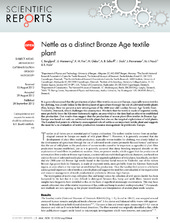Nettle as a distinct Bronze Age textile plant
Bergfjord, Christian; Mannering, Ulla; Frei, Karin M.; Gleba, Margarita; Scharff, Annemette Bruselius; Skals, Irene; Heinemeier, Jan; Nosch, Marie-Louise; Holst, Bodil
Peer reviewed, Journal article
Published version

Åpne
Permanent lenke
https://hdl.handle.net/1956/12377Utgivelsesdato
2012-09-28Metadata
Vis full innførselSamlinger
Originalversjon
https://doi.org/10.1038/srep00664Sammendrag
It is generally assumed that the production of plant fibre textiles in ancient Europe, especially woven textiles for clothing, was closely linked to the development of agriculture through the use of cultivated textile plants (flax, hemp). Here we present a new investigation of the 2800 year old Lusehøj Bronze Age Textile from Voldtofte, Denmark, which challenges this assumption. We show that the textile is made of imported nettle, most probably from the Kärnten-Steiermark region, an area which at the time had an otherwise established flax production. Our results thus suggest that the production of woven plant fibre textiles in Bronze Age Europe was based not only on cultivated textile plants but also on the targeted exploitation of wild plants. The Lusehøj find points to a hitherto unrecognized role of nettle as an important textile plant and suggests the need for a re-evaluation of textile production resource management in prehistoric Europe.
